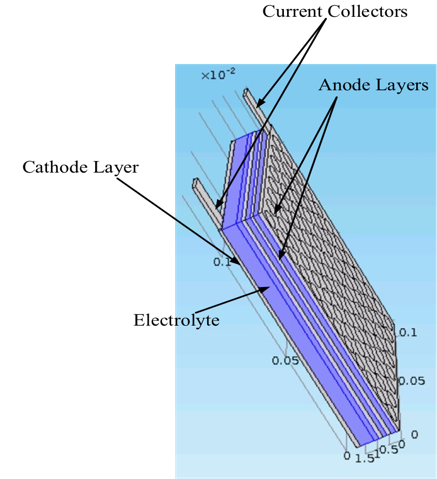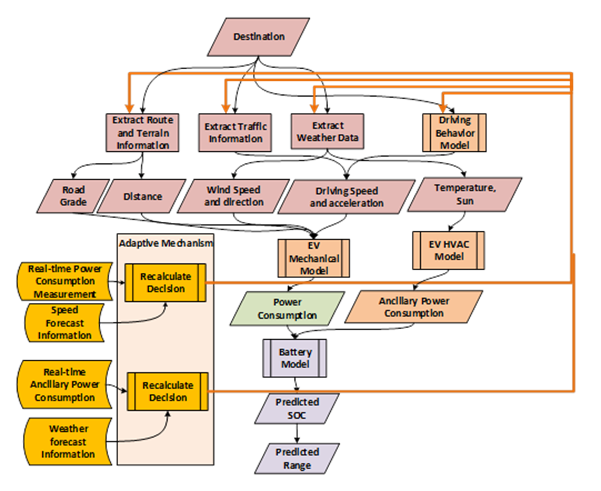First Principle Based Four Dimensional Battery Degradation Model (4DM)

The First Principle Based Four Dimensional Battery Degradation Model (4DM) is computer simulation model for battery dynamics studies under different degradation and operating conditions. The 4DM is designed based on the physics of operation of the battery, i.e., the actual components such as anode, cathode, electrolyte, separator and current collector, are used to construct the model. This particular approach is used to bridge the gap between material science, electrochemical and electrical engineering.
The 4DM, because of the design, is capable of simulating:
- different battery chemistries,
- batteries of different capacities,
- progressive component degradation,
- different operating conditions – C-rates, temperatures, depth of discharge, partial charging and discharging effects,
- component degradation over time.
The 4DM provides a platform to study the sensitivity of the battery’s rate of change of voltage and capacity with respect to the degradation of different physical and electrochemical components. This feature/capability of the 4DM enables users to better understand the impact of different operating conditions on the degradation of their battery and determine appropriate use cases for their batteries to prolong the remaining useful life.
The 4DM has an intuitive user-interface that assists the user to perform different tests on the model under different operating conditions. The user interface is designed to be simple, yet intuitive and capable of providing the user with sufficient options to understand the working of the 4DM with access to the core back-end tool with all the features.
Sponsor:
Co-Estimation Algorithm

Real-time estimation of the state of charge (SOC) of the battery is a crucial need in the growing fields of plug-in hybrid electric vehicles and smart grid applications. The SOC estimation accuracy depends on the accuracy of the model used to describe the characteristics of the battery. To accurately estimate the SOC of the battery, a Co-Estimation algorithm is proposed. The Co-Estimation algorithm is developed based on a resistance–capacitance (RC)-equivalent circuit model to model the battery dynamics. Considering the parameters of the battery model are functions of the SOC, C-rate, temperature, and aging, the Co-Estimation algorithm adopts an adaptive online parameter-identification algorithm to identify and update the model’s parameters as they change. We also deployed a piecewise linearized mapping of the VOC–SOC curve along with continuously updating the parameters to accurately represent all of the battery’s static and dynamic characteristics. Using this adaptive structure, we design an observer based on the updating model to estimate the SOC as one of the states of the battery model.
Sponsor:








High Temperature Embedded/Integrated Sensors for Remote Monitoring of Reactor and Fuel Cycle Systems (HiTEIS)

More than 10,000 sensors and detectors are usually adopted in a typical nuclear power plant (NPP) unit for measurements and controls of nuclear and non-nuclear processes, radiation monitoring, and other special applications including vibration measurements, hydrogen concentration monitoring, water conductivity and boric acid concentration measurement, or failed fuel detection, etc. (IAEA, 1999). Among a wide range of different sensing technologies, piezoelectric sensing has been increasingly used in temperature measurement, vibration monitoring, pressure and flow rate measurement, hydrogen concentration measurement, detection of water level and structural defects (Korsah, et al., 2009), largely due to the nature of compact assembly of piezoelectric devices and free from electromagnetic interference. However, harsh environments (high temperatures, high radiations, etc.) in nuclear reactors and fuel cycle systems greatly challenge the existing NPP sensing technology. Specifically, existing piezoelectric (including acoustic sensing) sensing techniques are mostly limited to applications at temperatures up to <250°C, by their lack of radiation resistance, their lack of embed-ability because of the wired electric power supply and communication, and their unknown long-term performance behavior under harsh environments.
In this project, we develop 1) high temperature (> 600°C) embedded/integrated sensors (HiTEIS) for wireless monitoring of temperature, vibration, water level, pressure and structural integrity; 2) investigate remote acoustic charging of HiTEISs using laser ultrasound; 3) implement nuclear environment compatible secured remote communication for HiTEISs; 4) verify the HiTEIS technology in reactor and fuel cycle environments.
Sponsor:

Big Data based Adaptive Range Estimation

The remaining driving range of an electric vehicle (EV) is a complex function of various types of data with different formats that need to be extracted and collected from different sources using big data analytics. In our previous project, we had designed a big data framework to extract, classify, and pre-analyze the data regarding the route, terrain, driving behavior, weather, etc. from different resources, and find the correlations between the data and range estimation.
In this project, we Incorporate and analyze the ancillary power consumed mainly by the heating, ventilating, and air conditioner (HVAC) system in calculating the driving range of the vehicle using big data analysis techniques. Moreover, the current version of the algorithm estimates the range based on certain assumptions about the driving conditions of each trip such as weather, driving behavior, road condition, etc. However, the driving conditions are subject to change due to unpredicted events along the trip (such as accidents, sudden climate changes, etc.) which can make the predicted range inaccurate. Therefore, we design an adaptive structure to update the predicted power consumption using weather forecast and traffic report information in real-time, to compensate for the changes in environmental and driving conditions.
Sponsor:
Prototyping a Smart Battery Gauge Technology for Stationary Energy Storage of Renewable Energy Resources
This project focuses on translating a novel Smart Battery Gauge technology to fill the increasing need for accurate battery state of charge (SOC) and remaining useful life (RUL) estimations for stationary energy storage of renewable energy. As compared to the existing battery monitoring methods, the reliably accurate estimation date generated by this technology will provide systems management and operations with the advantages of improved energy storage system efficiency, reliability, cost-effectiveness, longer lifespan, and reduced capital and operation/maintenance costs. In order to determine the technical feasibility and functional requirements of applying this technology in the stationary energy storage market and provide a commercially valuable solution, this project will result in a software prototype of the Smart Battery Gauge technology to demonstrate its real-time adaptive battery SOC and RUL estimations with market-leading accuracy and reliability, and its flexible customization for multiple different battery chemistries.
The objectives of this project are to:
1) Extract the relevant data and models that are needed for RUL estimation,
2) Design the adaptive predictive battery RUL estimation algorithm that can adjust battery parameters with real-time measurement feedback, and
3) Implement and demonstrate the Smart Battery Gauge technology prototype in software and benchmark its performance with existing approaches.



